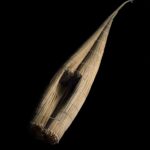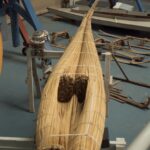Seahorse (caballito de totora)
Watercraft
Effect: Surfs-Up
Type: Reed
Composition: Reed
Place: Central & South America
Peruvians have been using caballitos for thousands of years as surfboards and fishing boats.
Seahorse (caballito de totora), 2004
Built by Carlos Huamanchumo
Hauncacho, Republic of Peru
Gift of Mr. & Mrs. Nelson H. Forbes, Mrs. Martha Wineman, Ms. Carole M. Lynn, Mr. Ralph Watson, Mr. & Mrs. Leonard R. Narramore, Ms. Clara L. Warren, and Mr. Hans Kuppers III
“Carlos has been making these boats for 25 years. His father built them as well. I would assume that he does not build more than 15 boats a year.” – Hans Kuppers III, 2004
Peruvians have been using caballitos for thousands of years as surfboards and fishing boats. When surfing, the rider kneels or sits just forward of the indentation to paddle out and then either sits or stands to ride the wave in.
Why is it called a seahorse?
Because caballitos are made of fexible reeds, riders appear to be astride a “galloping horse” in heavy waves. A caballito usually lasts for several months before it becomes waterlogged and needs to be replaced.
Origin: Huanchaco, Republic of Peru



